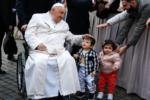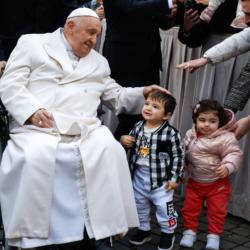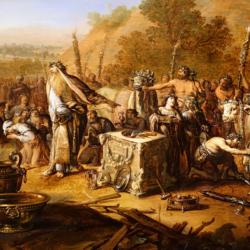Are big families back?
The Malthusian prediction of mass starvation due to overpopulation has been turned on its head. Now the cry is “Let’s Have More Babies!” Some countries have resorted to tax credits for having children -- Estonia is one. The fear is that there will not be enough workers to pay into tax coffers and insure old age benefits.
Europe looks like there was a famine that killed the babies. British historian Niall Ferguson calls this the greatest “sustained reduction in European population since the Black Death in the 14th century.” The dire picture -- apart from Muslim births --is the astonishing lack of new babies. Italy has one of the lowest birth rates: 1.2 percent. You can go into villages in northern Italy where inhabitants enjoy all the material things (in a manner their grandparents would never have dreamed) -- except children. By 2050, given present trends, 42 percent of Italians will be over 60 and nearly two out of three will have no brothers, sisters, aunts or uncles. Italy, Ireland and Spain -- famously Catholic countries -- are not coming even close to replacing themselves. One wag commented on the devastating demographic data that “by mid century Europe would be a theme park for the Chinese.”
Once Americans adored big families: The Kennedys and the Bush clan were admired for their solidarity and the fun they created together. But population researchers convinced an entire generation to lay off procreating and enter the career mold. Mothers went to work and whole neighborhoods emptied during the day. Moms could follow their career goals and delay their childbearing. Or not have children at all.
Some movies are showing big families again. And look around. Do you see big families more often than just a short while ago? However, Hollywood drives the social agenda; the themes are often born there. Three movies come to mind showing big families: “Nanny McPhee,” “Cheaper by the Dozen 2” and “Yours, Mine & Ours,” and none portray big families in a rosy light. The plots generally follow the disaster-at-the-dinner-table theme with food flying and chandeliers crashing. Real, off screen large families, oddly, are seldom ones with wildly misbehaving children. In real life, they tend to be orderly people with polite children, families in which older siblings are seen caring for their little sisters or brothers without griping about it. Onlookers are so taken in by the popular stereotype they are often surprised to see a large family acting peacefully.
One anecdote we cherish is the reason a couple gave for their joining the Roman Catholic Church. Surely not the only reason, but they said they were making Sunday visits to various churches and had to join the church where each week this little girl helped her younger sister with her coat
Social critic David Brooks recently declared of children that “three was the new two.” Social trends shift quickly--at least from one generation to the next. While our friends had two or maybe three children, our daughters are having more. (In the interest of full disclosure, we have 8 grandchildren. So far.)
Among our children’s cohort, big families are back. In these young Catholic families, the babies keep coming. Shoppers in the mall once said “I’m looking for something for work.” Increasingly we hear: “I need something for my daughter’s christening.” Before we get too bubbly, there are plenty of couples who have opted for material comforts over “creature” comforts. Or they have chosen pet comforts. But they will not have children messing up their careers and their non-family rooms.
Planned Parenthood’s longtime effort to retard population of undesirables will continue to advocate having only as many babies as you can indulge. Friends and even family will continue rudely to ask: “Is she going to have any more?”
Some of the benefits of big families are that children learn to be less self-centered. Large families provide plenty of opportunities to care for each other. Responsibility and maturity must come early. Not all children in large families respond well to the limitations of being one of many. But cooperation is a high priority. We know some children of large families who report fighting over food and time in the bathroom. Not everyone likes to share a bedroom, but still cooperation rules. Resources are limited and the large family doesn’t take for granted a yearly blowout family vacation.
Look ahead to the national landscape of limited or no children. In the years ahead, many, many Americans are going to be like tomorrow’s Italians. Picture having no brothers or sisters or cousins to help them raise their one or maybe two children. Envision Christmas and other holidays with no big family gathering: just the two or three of you having turkey in a restaurant and weddings and funerals populated only with friends. The merriment of a large family is absent. Picture having no one to visit you in the golden years.
There is, of course, a larger and more fundamental reason to turn this tide of tiny families. We are called in the very first book of the Bible to be fruitful and multiply (Gen 1:27). But think, too, of the value of the large Catholic families who will supply the new priests and religious needed to continue the faith.
Kevin and Marilyn Ryan edited “Why I Am Still a Catholic” [Riverhead Books, 1998] and live in Chestnut Hill, Mass.

















